
The Peloponnese, Peloponnesus or Morea is a peninsula and geographic region in Southern Greece, and the southernmost region of the Balkans. It is connected to the central part of the country by the Isthmus of Corinth land bridge which separates the Gulf of Corinth from the Saronic Gulf. From the late Middle Ages until the 19th century, the peninsula was known as the Morea, a name still in colloquial use in its demotic form.
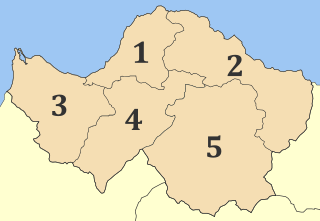
Achaea or Achaia, sometimes transliterated from Greek as Akhaia, is one of the regional units of Greece. It is part of the region of Western Greece and is situated in the northwestern part of the Peloponnese peninsula. The capital is Patras which is the third largest city in Greece.

The Greek War of Independence, also known as the Greek Revolution or the Greek Revolution of 1821, was a successful war of independence by Greek revolutionaries against the Ottoman Empire between 1821 and 1829. In 1826, the Greeks were assisted by the British Empire, Kingdom of France, and the Russian Empire, while the Ottomans were aided by their North African vassals. The war led to the formation of modern Greece, which would be expanded to its modern size in later years. The revolution is celebrated by Greeks around the world as independence day on 25 March.

The Orlov revolt was a Greek uprising in the Peloponnese and later also in Crete that broke out in February 1770, following the arrival of Russian Admiral Alexey Orlov, commander of the Imperial Russian Navy during the Russo-Turkish War (1768–1774), at the Mani Peninsula. The revolt, a major precursor to the Greek War of Independence, was part of Catherine the Great's so-called "Greek Plan" and was eventually suppressed by the Ottomans.

Aigio, also written as Aeghion, Aegion, Aegio, Egio, is a town and a former municipality in Achaea, West Greece, on the Peloponnese. Since the 2011 local government reform, it is part of the municipality Aigialeia, of which it is the seat and a municipal unit.
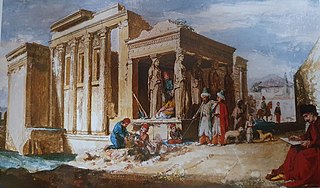
The vast majority of the territory of present-day Greece was at some point incorporated within the Ottoman Empire. The period of Ottoman rule in Greece, lasting from the mid-15th century to the successful Greek War of Independence that broke out in 1821 and the First Hellenic Republic was proclaimed in 1822, is known in Greek as Tourkokratia. Some regions, however, like the Ionian islands and various temporary Venetian possessions of the Stato da Mar were not incorporated in the Ottoman Empire. The Mani Peninsula in Peloponnese was not fully integrated into the Ottoman Empire, but was under Ottoman suzerainty.
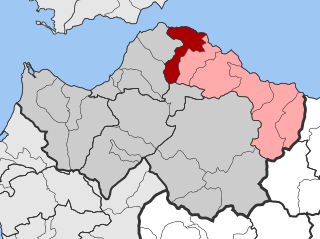
Erineos is a former municipality in Achaea, West Greece, Greece. Since the 2011 local government reform it is part of the municipality Aigialeia, of which it is a municipal unit. The municipal unit has an area of 98.710 km2. Its seat of administration was in the village of Lampiri. Erineos stretches between the northeastern slopes of the Panachaiko mountain and the Gulf of Corinth. The river Foinikas (Phoenix) flows through the municipality. The Greek National Road 8A and the railway from Patras to Corinth run through the municipal unit. It is located about 10 km west of Aigio.

Filiki Eteria or Society of Friends was a secret political and revolutionary organization founded in 1814 in Odessa, whose purpose was to overthrow the Ottoman rule of Greece and establish an independent Greek State. Society members were mainly young Phanariot Greeks from Constantinople and the Russian Empire, local political and military leaders from the Greek mainland and islands, as well as several Orthodox Christian leaders from other nations that were under Hellenic influence, such as Karađorđe from Serbia, and Tudor Vladimirescu from Romania. One of its leaders was the prominent Phanariote Prince Alexander Ypsilantis. The Society initiated the Greek War of Independence in the spring of 1821.

Chalandritsa is a town and a community in Achaea, West Greece, Greece. Since 2011 local government reform it is part of the municipality Erymanthos, of which it is the seat of administration. Chalandritsa is situated in hills north of the river Peiros, 17 km south of Patras. The community consists of the settlements Chalandritsa, Mastoraiika-Stamaiika and Kydonies. From 1835 until 1912, and again from 1998 until 2011 it was a municipal district and the seat of the municipality of Farres. Chalandritsa is at the edge of a seismic fault, which caused a minor earthquake in February 2008.

Agia Lavra is a monastery near Kalavryta, Achaea, Greece. It was built in 961 AD, on Chelmos Mountain, at an altitude of 961 meters, and can be described as the symbolic birthplace of modern Greece. It stands as one of the oldest monasteries in the Peloponnese.
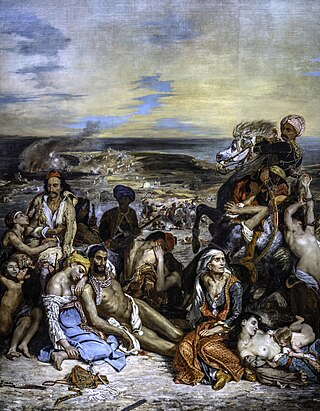
There were numerous massacres during the Greek War of Independence (1821–1829) perpetrated by both the Ottoman forces and the Greek revolutionaries. The war was characterized by a lack of respect for civilian life, and prisoners of war on both sides of the conflict. Massacres of Greeks took place especially in Ionia, Crete, Constantinople, Macedonia and the Aegean islands. Turkish, Albanian, Greeks, and Jewish populations, who were identified with the Ottomans inhabiting the Peloponnese, suffered massacres, particularly where Greek forces were dominant. Settled Greek communities in the Aegean Sea, Crete, Central and Southern Greece were wiped out, and settled Turkish, Albanian, Greeks, and smaller Jewish communities in the Peloponnese were destroyed.
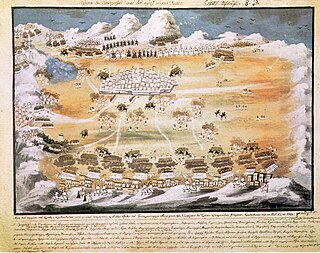
The siege of Tripolitsa or fall of Tripolitsa, also known as the Tripolitsa massacre, was an early victory of the revolutionary Greek forces in the summer of 1821 during the Greek War of Independence, which had begun earlier that year, against the Ottoman Empire. Tripolitsa was an important target, because it was the administrative center of the Ottomans in the Peloponnese.
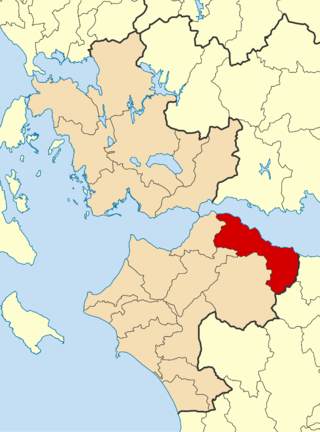
Aigialeia is a municipality and a former province (επαρχία) in the eastern part of the Achaea regional unit, Greece. The seat of the municipality is the town Aigio. The municipality has an area of 723.063 km2. The main towns are Aigio, Akrata and Diakopto. The municipality Aigialeia stretches from the south coast of the Gulf of Corinth to the mountainous interior of the Peloponnese peninsula. The main rivers of the municipality are the Selinountas and the Vouraikos.
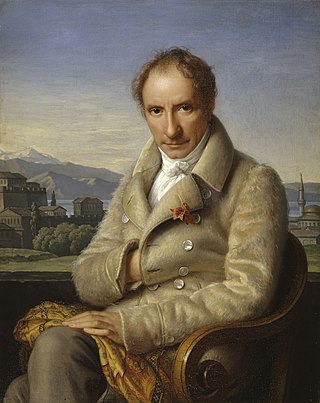
François Charles Hugues Laurent Pouqueville was a French diplomat, writer, explorer, physician and historian, and member of the Institut de France.

The Fall of Constantinople in 1453 and the subsequent fall of the successor states of the Eastern Roman Empire marked the end of Byzantine sovereignty. Since then, the Ottoman Empire ruled the Balkans and Anatolia, although there were some exceptions: the Ionian Islands were under Venetian rule, and Ottoman authority was challenged in mountainous areas, such as Agrafa, Sfakia, Souli, Himara and the Mani Peninsula. Orthodox Christians were granted some political rights under Ottoman rule, but they were considered inferior subjects. The majority of Greeks were called rayas by the Turks, a name that referred to the large mass of subjects in the Ottoman ruling class. Meanwhile, Greek intellectuals and humanists who had migrated west before or during the Ottoman invasions began to compose orations and treatises calling for the liberation of their homeland. In 1463, Demetrius Chalcondyles called on Venice and “all of the Latins” to aid the Greeks against the Ottomans, he composed orations and treatises calling for the liberation of Greece from what he called “the abominable, monstrous, and impious barbarian Turks.” In the 17th century, Greek scholar Leonardos Philaras spent much of his career in persuading Western European intellectuals to support Greek independence. However, Greece was to remain under Ottoman rule for several more centuries. In the 18th and 19th century, as revolutionary nationalism grew across Europe—including the Balkans —the Ottoman Empire's power declined and Greek nationalism began to assert itself, with the Greek cause beginning to draw support not only from the large Greek merchant diaspora in both Western Europe and Russia but also from Western European Philhellenes. This Greek movement for independence, was not only the first movement of national character in Eastern Europe, but also the first one in a non-Christian environment, like the Ottoman Empire.

The Eyalet of the Morea was a first-level province (eyalet) of the Ottoman Empire, centred on the Peloponnese peninsula in southern Greece.

The Kingdom of the Morea or Realm of the Morea was the official name the Republic of Venice gave to the Peloponnese peninsula in Southern Greece when it was conquered from the Ottoman Empire during the Morean War in 1684–99. The Venetians tried, with considerable success, to repopulate the country and reinvigorate its agriculture and economy, but were unable to gain the allegiance of the bulk of the population, nor to secure their new possession militarily. As a result, it was lost again to the Ottomans in a brief campaign in June–September 1715.
The Diocese of Lacedaemon o Lacedaemonia was a Christian ecclesiastical province in Laconia, Greece. Extant from at least the middle of the 5th century, it became a metropolis in 1083. During the period of Frankish rule, between ca. 1209 and 1278, it was held by Roman Catholic prelates, and remains a (vacant) titular see of the Catholic Church. The Greek Orthodox see was restored with the Byzantine reconquest in the 1270s, and continued until the see's abolition in 1852.

Dimitrios Meletopoulos was a Greek revolutionary leader of the Greek War of Independence and later a politician.
The Londos family was a military family from Vostitsa, which flourished during the last century of Ottoman rule in Greece, through the Greek War of Independence. They declined in prominence beginning in the 1840s.































